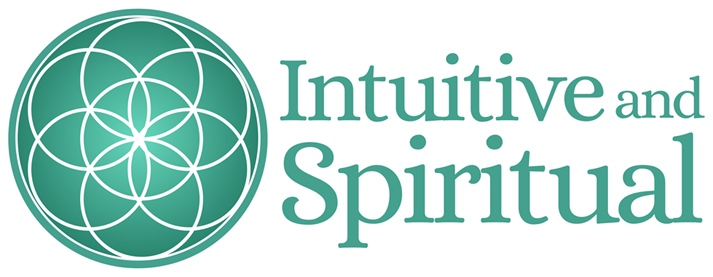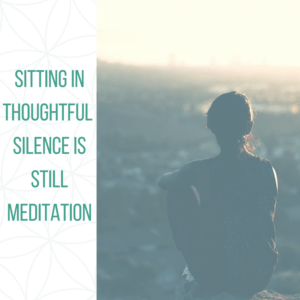Meditation for Those That Think They Can’t
Let’s set the record straight: any time you sit in silence and bring awareness to your breath, that is meditation.
This applies if your mind is blank or full, happy, sad and everything between.
And it doesn’t matter if you’re a “newbie” (noob) or you feel like you haven’t had much success in meditating before (goob). This is all about you and being kind and gentle to yourself.
[bctt tweet=”The act of being silent – no matter how busy the mind – is a form of meditation.” username=”n2itvnspiritual”]
I used to think that in order to meditate, everything had to be perfect: the perfect pose, the perfect candle, the systematic clearing of my mind. And even though I tried to be gentle with myself, I still was always slightly annoyed when I couldn’t achieve the perfect “blank mind.”
Then I thought,”Well now…I’m missing the point, aren’t I?”
Eventually I decided that sitting in silence – the act itself – was a huge step in becoming a lifelong meditator.
I don’t think I’ve ever had a meditation session without thinking a thousand thoughts. The mind is designed to think.
Sitting In Silence
To folks that are completely new to it or have struggled with it in the past, my advice is to just get in the habit of sitting – silently – every morning when you wake up for about 20 minutes.
That’s pretty much how I got into it.
There’s no need to light a candle, no need to change into different clothes or have the perfect pose. Just sitting in silence is a huge first step.
And if you’re content with that, then you have succeeded.
See, meditation is about non-judgement and giving the mind a place to “just be.”
I suggest doing this in the morning because when you’re not quite awake, your subconscious mind is at work and is more likely to help you shift into a quiet state. That and if the rest of the world isn’t up, yet, it’s easier to not get distracted from…just sitting.
If you can get into the habit of doing this for 30 days, then you’re likely to continue, too.
And honestly, after years of meditation, I find that mornings are best: the world is still quiet, the birds are still asleep (at least at the time that I do it), and since I’m not quite “awake”, I remain in that “in-between” world of sleep and wakefulness, when the mind is open to possibility.
Silent Meditation
Now, if you’d like to challenge yourself and bring a little more formality to your practice, then you can ratchet up your practice.
The one thing to remember is that this is a practice.
There’s no pressure.
It’s all about being gentle, and not stressing out about doing things perfectly.
You’re doing it correctly by showing up and sitting. That’s it.
Tthinking is allowed: the point is to chill out.
But let’s say you’ve just fallen in love with silence. It really is “powerful and loud” once you bring it into your life.
How now can you improve upon what you’re doing to help your mind to get still?
Posture
The first is to work on your posture. Cross your legs or if your feet tend to fall asleep like mine do, you can sit on a blanket or cushion and then try crossing your legs. Try keeping your head directly over your heart and straightening your back.
Let your hands rest on top of each other, in such a way that your right or left hand is on top and your thumbs are touching. Then rest them upon your legs.
I often see people in meditation poses with their arms out and palms up, with their forefinger and thumbs touching. This is called a mudra. If you like doing that, that’s just fine.
Just do what you’re comfortable with.
Breathe
Now, just breathe. In and out, in and out. Don’t worry if thoughts come to mind.
You see, thoughts will come. They always, always do. And sometimes your mind is going to follow them and you’ll go on a whole thought tangent. Minutes may pass by.
You know what? This is okay. I’ve been meditating for years and this still happens – nearly every day.
But that’s what this is all about: it’s your own journey. And it’s “your meditation.” It’s seriously okay if you end up thinking about something.
When you become aware that you’re followed a thought train, acknowledge it and then return to breathing in and out. Let the thought go.
Becoming aware and focusing on breathing actually require thinking.
The idea is that you can’t go against your mind’s nature. But you can redirect its thoughts to help you achieve more calm.
I really think that too many people get hung up on the fact that “they’re not supposed to think” during meditation. I’m here to tell you that with practice, yes, it is possible to “think less” but “thinking” is part of the process.
Two Minds
However, if you’re really into meditation and want to work more on the whole “blank mind” concept, there are a few things you can do to help achieve that.
First is to imagine your mind as two separate entities. There’s the regular mind that thinks its thoughts and it continues in a whole “running stream of consciousness.”
Then there’s another part of the mind that can separate from all those thoughts and become aware of what it’s thinking.
Let’s say you’re sitting in a nice meditation pose and you hear the neighbor’s dog. A thought about your own dog enters your mind and then you begin to think how crazy he is, and that if it were you, you’d train that dog some more.
Your mind has started to go on a tangent – which is okay.
But maybe you want to focus more on “not thinking,” right? So, you label that thought. “Thinking.”
In the next breath you take, you focus again on your breath and tell yourself, “Breathing.”
You’ve successfully refocused your mind back on your breathing through a “second mind” awareness.
So, you see, there are essentially two minds at work here: the one that’s mindlessly thinking and the one that mindfully redirects your thinking to breathing – and gives it a label.
Let’s say you hear a bird while you’re mediating and you smile. You think of the sounds it makes and its beauty.
Your mind has gone on another tangent. And if you “follow” that thought, you might think of a pet bird you had or if that bird you heard was the first one to sing during those early-morning hours.
Sometimes you’ll forget and keep following those thoughts.
And guess what?
You probably know what I’m going to say: it’s okay!
But, part of the fun is catching yourself before you go too much on a tangent. You label your thinking as “Thinking” and then take another breath and tell yourself, “Breathing.”
Take more deep breaths. In and out. In and out.
More thoughts will come. Maybe you’ll follow them. Maybe you’ll redirect and become aware of your breathing. Either way, you’re working on your awareness.
Becoming a Mountain
Another way to look at meditation is from the “mountain” perspective. You can imagine that your body and the meditation pose you’ve adopted is like a mountain.
As thoughts pass over you, they are like passing clouds near the peak of the mountain. You see those thoughts and then, as you redirect back to your breath, you see those thoughts roll by and dissipate.
Or maybe you don’t want to be a mountain. Maybe you’re a large rock in a stream and your thoughts are like water. They roll and maybe splash over you, but in an instant, they’re downstream.
The Challenge
So, here’s the challenge. Why not try for five minutes? See what happens. See if you can take deep breaths for five minutes and as thoughts come – remember, they will – see if you can gently let them roll by and take more deep breaths.
Let me know how it goes!




I think many stop the practice of meditation due to rigidity in expectations and procedures.
Your approach is kind, individualized and accepting, dear Cynthia. I can very much see you conducting classes and workshops on meditation and mindfulness.
Wonderful post – sharing with all. Love, Maria
Maria – this is *so* true. There’s this crazy stereotype that if you can’t clear your head in the first five minutes, that it’s not beneficial and so they’ll never do it again.
I’m like, you know…I’ve been practicing since 2003 and I’m here to tell you that my mind STILL likes to wander. And it’s okay. It’s a practice. 🙂 Even the monks spend 4 hours meditating and it takes them a long time to reach enlightenment…hehe.
And you have hit the nail on the head with your comment about teaching classes. I’m in the process of signing up for a mindfulness certification course. I *must* teach this – I just love it so!
Thank you again for the shares. I just appreciate you so much! Again, you have made my heart swell with your wise and kind words! <3